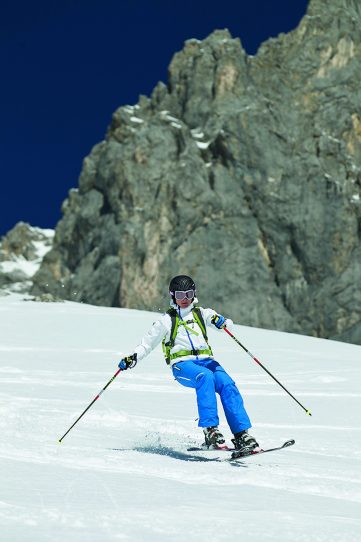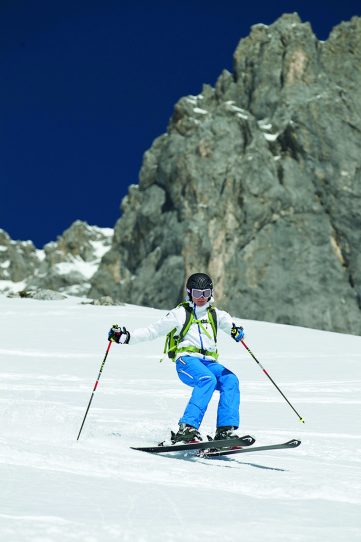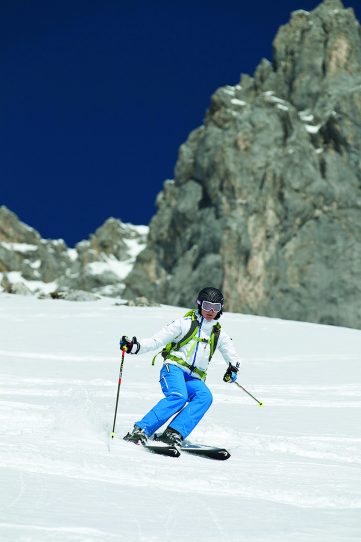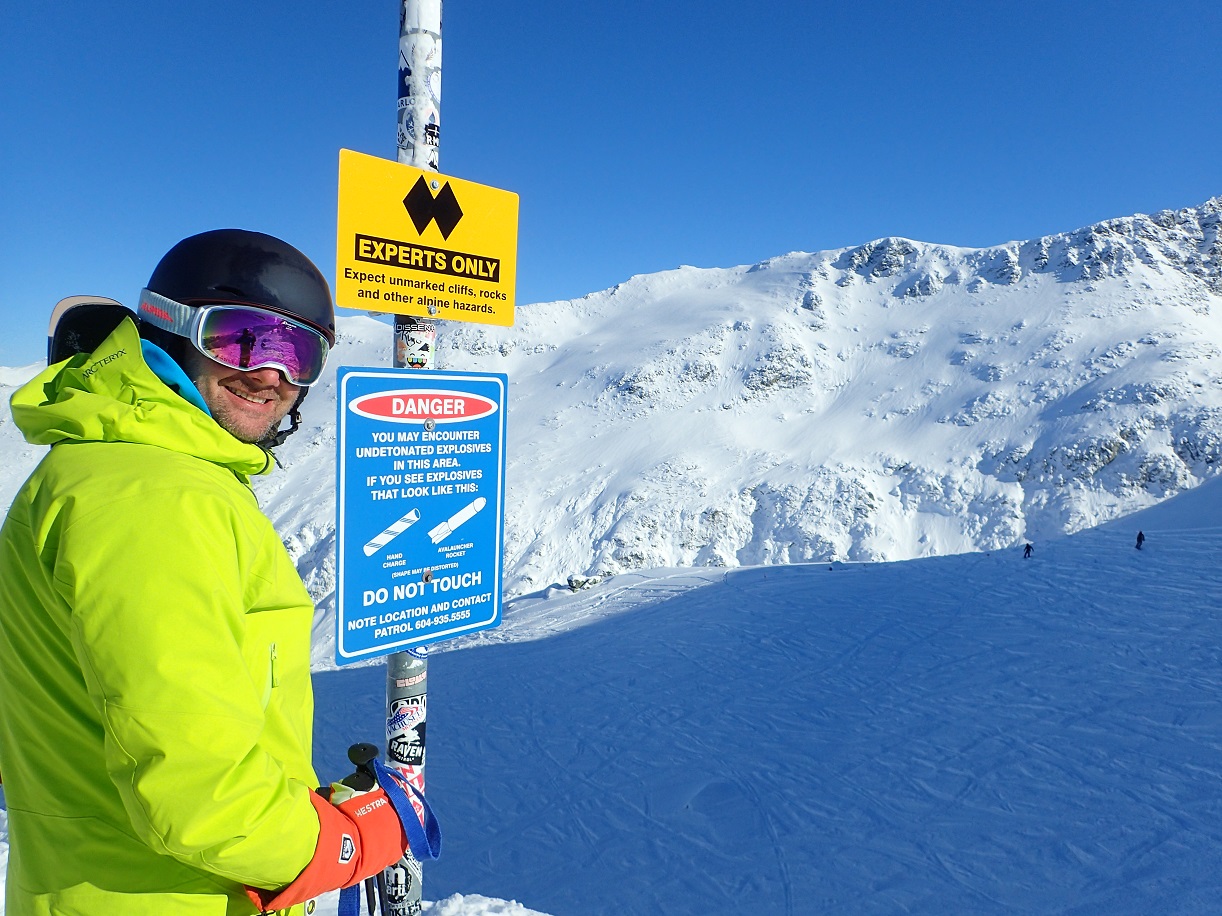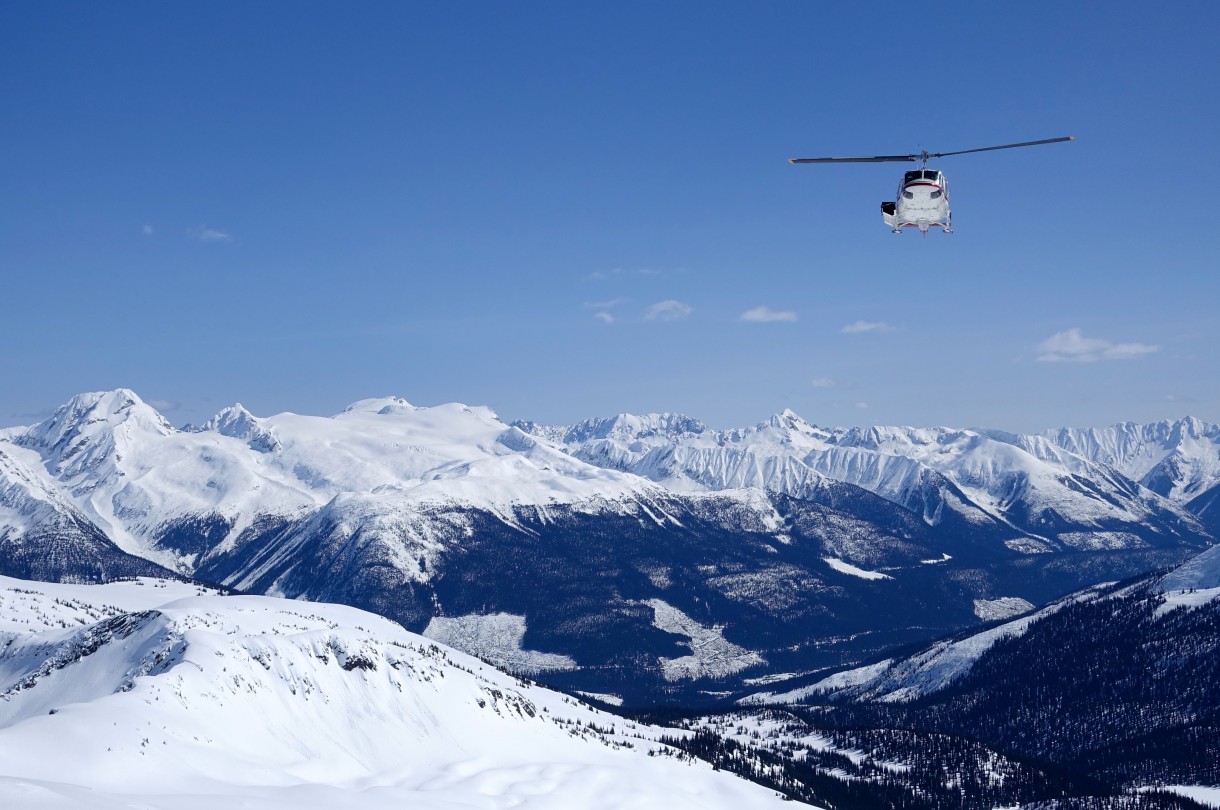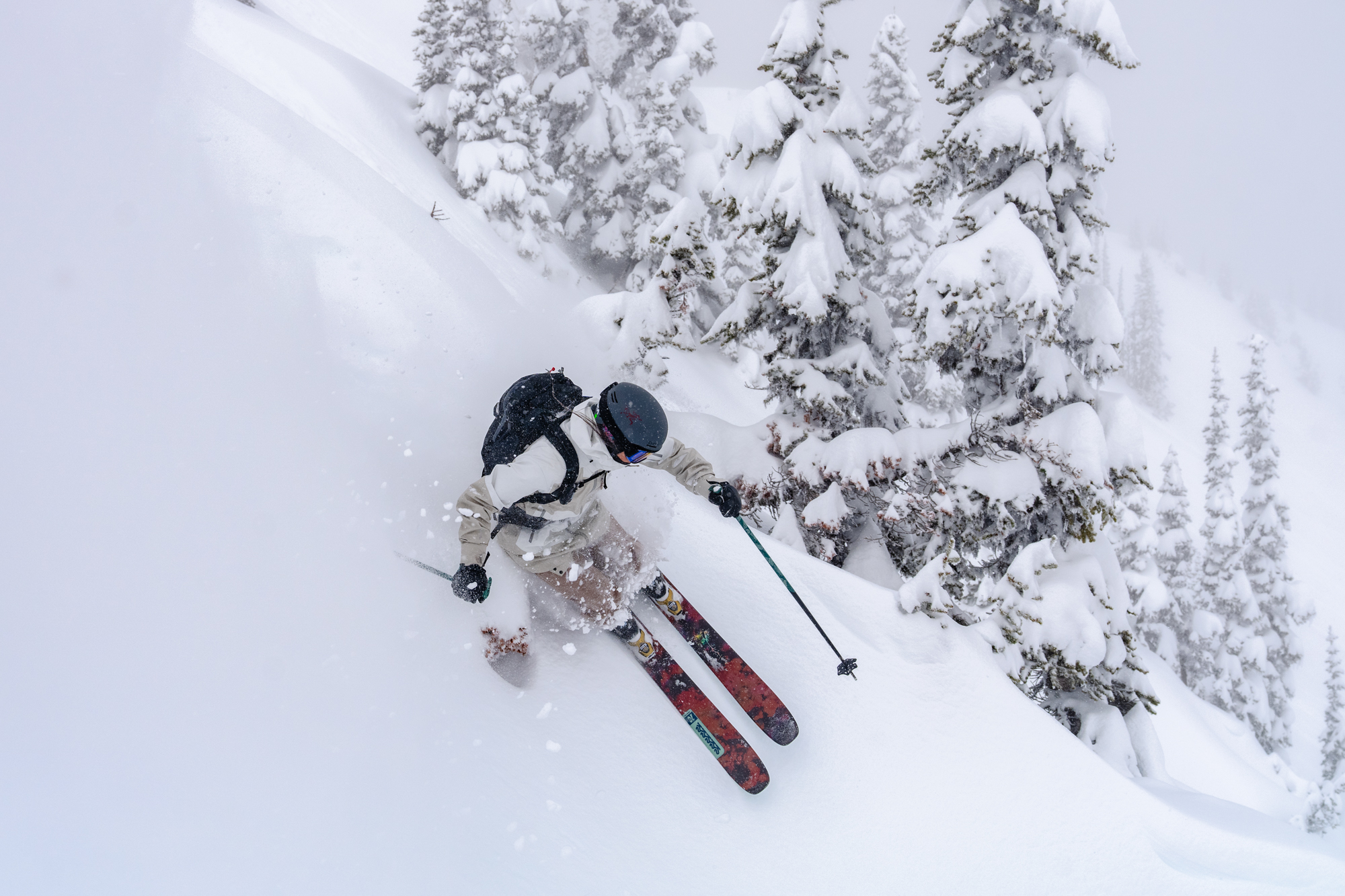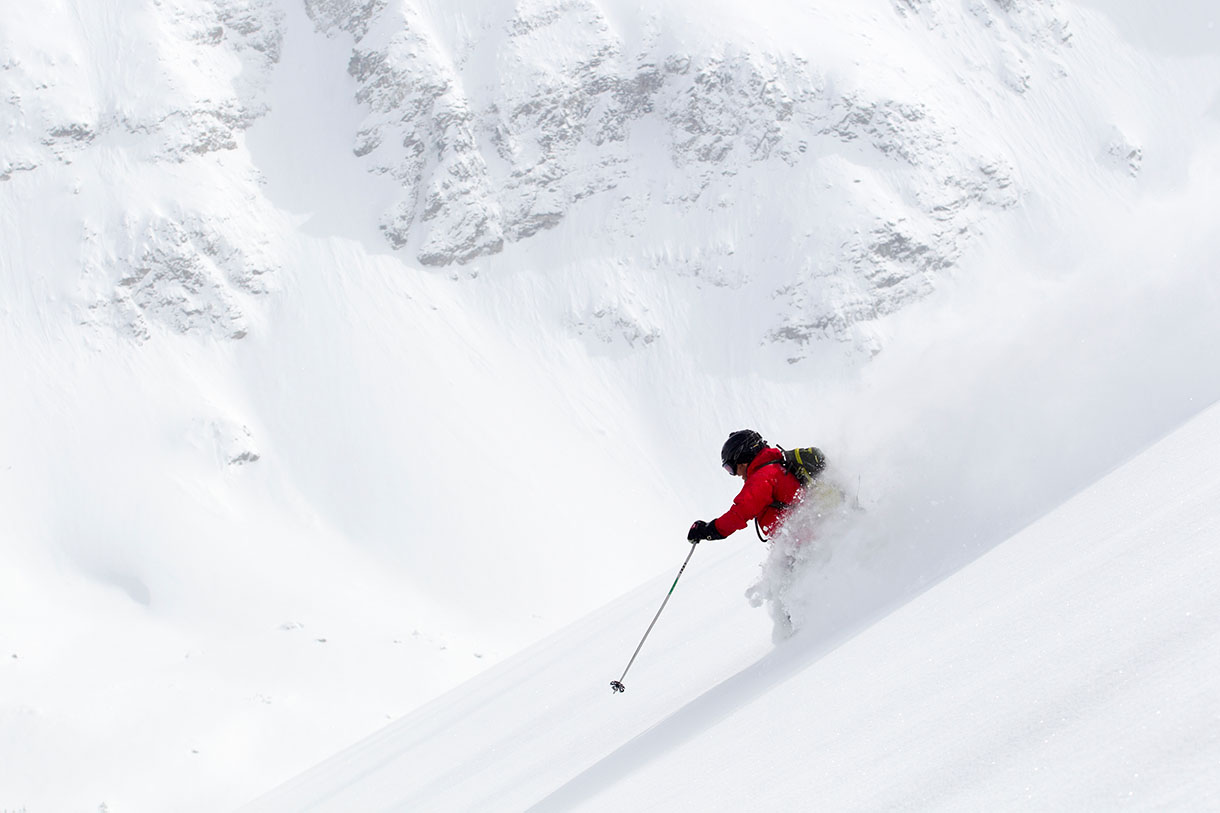
The most important basics for deep snow skiing
Deep snow skiing looks playfully easy for experts. Unfortunately, it’s not that easy in reality – but not as hard as many fear, either. With the right technique and a few tips, fun in the powder is guaranteed. SKI KANADA, SKI USA and the experts of the German Ski Instructors Association (DSLV) show how it’s done.
Powdering for beginners & advanced: We show how!
 Sinking into deep and soft snow and the increased resistance is still unfamiliar at the beginning and causes balance problems. Every weight shift to the front, back or side causes the skis to dive accordingly, which must be prevented by counter or compensating movements. This is best tested in easy terrain. Short deep snow passages next to or between groomed slopes are suitable for this. For the first attempts, the skiing distances should not be too long, because a lot of strength is lost through possible falls and the associated laborious getting up. At a slow pace, however, falling and letting yourself fall into soft snow can be huge fun. And most importantly, it takes away the fear of falling. And remember the old basic rule: If you don’t fall, you don’t learn.
Sinking into deep and soft snow and the increased resistance is still unfamiliar at the beginning and causes balance problems. Every weight shift to the front, back or side causes the skis to dive accordingly, which must be prevented by counter or compensating movements. This is best tested in easy terrain. Short deep snow passages next to or between groomed slopes are suitable for this. For the first attempts, the skiing distances should not be too long, because a lot of strength is lost through possible falls and the associated laborious getting up. At a slow pace, however, falling and letting yourself fall into soft snow can be huge fun. And most importantly, it takes away the fear of falling. And remember the old basic rule: If you don’t fall, you don’t learn.
Get used to deep snow
Especially deep snow novices should slowly get used to skiing in soft snow. A few exercises make it easy to get started:
– In deep snow, walk with skis, push, run, bounce, teeter, stride, jump,
– In deeper snow, glide straight ahead while bobbing (in all directions), jumping, shifting skis, skiing on one leg, skiing on both legs, …
– Skiing from tracked snow to untracked snow and vice versa.
– Turning in deep snow with a lot of tracks, later in deep snow with less tracks, etc.
– Turning in not too deep snow, later in slightly deeper snow.
The basics of skiing in deep snow
You should stand on both legs
It’s all about using the support surface of the inside ski properly. In soft snow, the load should be distributed as equally as possible on both legs to prevent sinking in on one leg. Basically, however, the extra load remains on the outside ski. During the turn, consciously and clearly try to load the inside ski as well. The maximum load contrast is shown when the outer ski is lifted once or even several times in a turn. This task additionally trains the balance and can be skied first on a groomed slope, then in tracked deep snow or even in low deep snow.
Form a block with both legs!
If skied with a tighter leg position, the surface effect of the skis increases in soft snow, which increases lift. This makes skiing in powder much easier. When the legs are squeezed together, in most cases the inner ski is also
inner ski is also subjected to a greater load and larger canting movements from the legs are made more difficult – this can result in three advantages at once. For this task, the legs are sometimes pressed together more strongly, sometimes more weakly into a block during the turn. This task can also be tried out first on the prepared slope.
The rhythm is everything: up and down, again and again


Always stay in rhythm – that’s one of the basic rules of deep snow skiing. When changing turns, stretch or straighten up to take more weight off the skis and make them easier to turn on – when steering, bend or go low in a measured and even manner to better regulate the load. A steady and rhythmic rise and fall during the turn compresses the soft snow through greater load and allows the compaction effect to occur, which can be used to change the turn. The more dynamic the upward movement, the greater the relief. When practicing, this can easily lead to the skis lifting off. In deep snow, this is known as the jump effect, which leads to a feeling of floating. This is just as noticeable on the slopes, only here you don’t push off the entire running surface as in deep snow, but off the edge.
Jetten
If the uprighting is carried out dynamically to the rear in the turn change, one speaks of jetting, because then the ski tips rise like a jet plane and are lifted out of the deep snow.
This is exhausting, but makes it easier to ski in deep snow that is difficult to turn. In North America, the powder is usually wonderfully dry and easy to ski, but wet snow is hard and then jetting helps tremendously. Jetting is also very good to learn on the slopes.
News
[qodef_blog_list type=“masonry“ number_of_columns=“one“ space_between_items=“small“ orderby=“date“ order=“DESC“ image_size=“custom“ post_info_author=“no“ post_info_date=“no“ post_info_category=“no“ number_of_posts=“2″ category=“news“ custom_image_width=“316″ custom_image_height=“178″]Partner
News
[qodef_blog_list type=“masonry“ number_of_columns=“one“ space_between_items=“small“ orderby=“date“ order=“DESC“ image_size=“custom“ post_info_section=“no“ number_of_posts=“2″ category=“news“ custom_image_width=“316″ custom_image_height=“178″]Partner
Leave a Comment
Du musst angemeldet sein, um einen Kommentar abzugeben.


